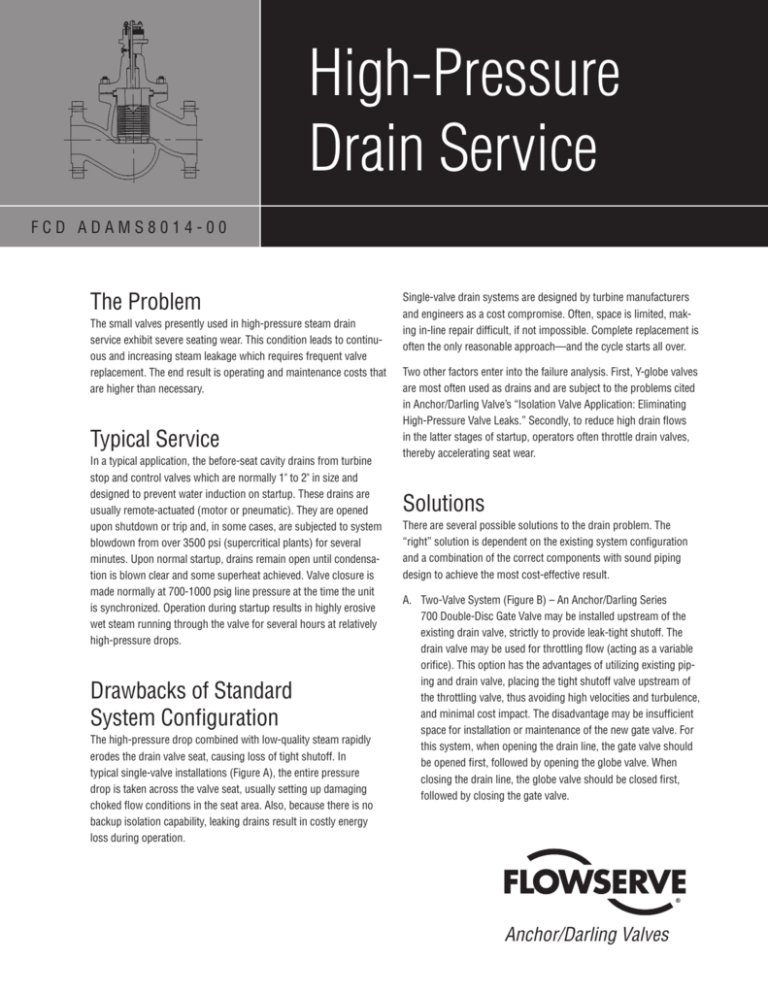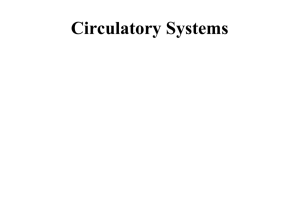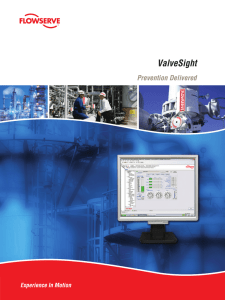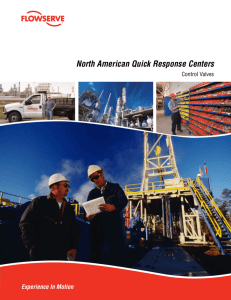High-Pressure Drain Service
advertisement

High-Pressure Drain Service FCD ADAMS8014-00 The Problem The small valves presently used in high-pressure steam drain service exhibit severe seating wear. This condition leads to continuous and increasing steam leakage which requires frequent valve replacement. The end result is operating and maintenance costs that are higher than necessary. Typical Service In a typical application, the before-seat cavity drains from turbine stop and control valves which are normally 1" to 2" in size and designed to prevent water induction on startup. These drains are usually remote-actuated (motor or pneumatic). They are opened upon shutdown or trip and, in some cases, are subjected to system blowdown from over 3500 psi (supercritical plants) for several minutes. Upon normal startup, drains remain open until condensation is blown clear and some superheat achieved. Valve closure is made normally at 700-1000 psig line pressure at the time the unit is synchronized. Operation during startup results in highly erosive wet steam running through the valve for several hours at relatively high-pressure drops. Drawbacks of Standard System Configuration The high-pressure drop combined with low-quality steam rapidly erodes the drain valve seat, causing loss of tight shutoff. In typical single-valve installations (Figure A), the entire pressure drop is taken across the valve seat, usually setting up damaging choked flow conditions in the seat area. Also, because there is no backup isolation capability, leaking drains result in costly energy loss during operation. Single-valve drain systems are designed by turbine manufacturers and engineers as a cost compromise. Often, space is limited, making in-line repair difficult, if not impossible. Complete replacement is often the only reasonable approach—and the cycle starts all over. Two other factors enter into the failure analysis. First, Y-globe valves are most often used as drains and are subject to the problems cited in Anchor/Darling Valve’s “Isolation Valve Application: Eliminating High-Pressure Valve Leaks.” Secondly, to reduce high drain flows in the latter stages of startup, operators often throttle drain valves, thereby accelerating seat wear. Solutions There are several possible solutions to the drain problem. The “right” solution is dependent on the existing system configuration and a combination of the correct components with sound piping design to achieve the most cost-effective result. A. Two-Valve System (Figure B) – An Anchor/Darling Series 700 Double-Disc Gate Valve may be installed upstream of the existing drain valve, strictly to provide leak-tight shutoff. The drain valve may be used for throttling flow (acting as a variable orifice). This option has the advantages of utilizing existing piping and drain valve, placing the tight shutoff valve upstream of the throttling valve, thus avoiding high velocities and turbulence, and minimal cost impact. The disadvantage may be insufficient space for installation or maintenance of the new gate valve. For this system, when opening the drain line, the gate valve should be opened first, followed by opening the globe valve. When closing the drain line, the globe valve should be closed first, followed by closing the gate valve. ��������������������� B. Single Valve with Orifice (Figure C) – A single Series 700 Gate Valve and a fixed orifice, either single or multi-stage (for noise control), may replace the standard drain valve. The advantages of this arrangement are simplicity of maintenance and economy of space while taking the pressure drop across the orifice and minimizing valve wear. The orifice assembly should be placed downstream from the valve a minimum of ten pipe diameters. The disadvantages are that the orifice must be larger than ¾" to comply with ASME guidelines*, or it may be susceptible to plugging. Throttling of flow is not permitted (nor should any be necessary). Finally, a larger discharge line should be considered downstream of the orifice to obtain lower velocities. C. Two Valves with a Fixed Orifice (Figure D) – Combines options A and B, meeting the requirements for minimum size orifice, while Figure A Figure B Main Steam Main Steam Motor or Air-Actuated Globe Drain Valve (Normal flow under the seat, which is appropriate) providing the longevity and simplicity of an optimally sized fixed orifice. (All parts can be incorporated into one prefabricated assembly.) The disadvantage is the higher relative cost. Summary Whereas the cost of any of the proposed options exceeds the original equipment single-valve arrangement, the difference will be offset in the dramatic savings affected by lower maintenance and lost energy costs. Actual installations using Anchor/Darling Series 700 Double-Disc Gate Valves have provided excellent results. *ASME Standard TDP-1-1980 (Section 3.3-3.6) Figure C Figure D Main Steam Anchor/Darling Double-Disc Gate Valve (Motor or airactuated optional) Drain Valve To Condenser To Condenser Main Steam Anchor/Darling Double-Disc Gate Valve Anchor/Darling Double-Disc Gate Valve Fixed Orifice – Single or Multi-Stage Fixed Orifice To Condenser Globe Bypass Valve To Condenser Flowserve Corporation has established industry leadership in the design and manufacture of its products. When properly selected, this Flowserve product is designed to perform its intended function safely during its useful life. However, the purchaser or user of Flowserve products should be aware that Flowserve products might be used in numerous applications under a wide variety of industrial service conditions. Although Flowserve can (and often does) provide general guidelines, it cannot provide specific data and warnings for all possible applications. The purchaser/user must therefore assume the ultimate responsibility for the proper sizing and selection, installation, operation, and maintenance of Flowserve products. The purchaser/user should read and understand the Installation Operation Maintenance (IOM) instructions included with the product, and train its employees and contractors in the safe use of Flowserve products in connection with the specific application. While the information and specifications contained in this literature are believed to be accurate, they are supplied for informative purposes only and should not be considered certified or as a guarantee of satisfactory results by reliance thereon. Nothing contained herein is to be construed as a warranty or guarantee, express or implied, regarding any matter with respect to this product. Because Flowserve is continually improving and upgrading its product design, the specifications, dimensions and information contained herein are subject to change without notice. Should any question arise concerning these provisions, the purchaser/user should contact Flowserve Corporation at any one of its worldwide operations or offices. For more information about Flowserve Corporation, visit www.flowserve.com or call USA 1-800-225-6989. ��������������������� © 2004 Flowserve Corporation, Irving, Texas, USA. Flowserve is a registered trademark of Flowserve Corporation. (Part HPDS) FCD ADAMS8014-00 Printed in USA.






